Moon phases don’t actually change with seasons – they always follow the same 29.5-day cycle from new to full moon. What does change seasonally is how you experience the moon. Earth’s 23.5-degree tilt affects the moon’s path across your night sky, causing higher summer arcs with longer visibility and lower winter paths. Seasonal atmospheric conditions also impact brightness and clarity. The moon even appears at different positions and times depending on your hemisphere and time of year.
The Basic Mechanics of Moon Phases
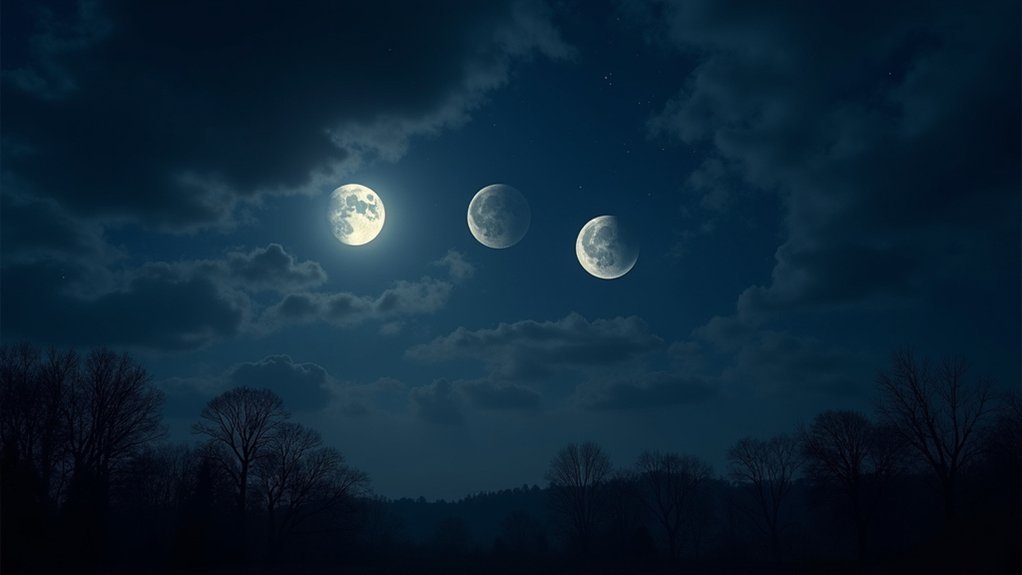
While we observe the Moon’s changing appearance throughout each month, these transformations follow a predictable pattern driven by celestial mechanics.
The Moon’s phases occur as it completes its orbit around the Earth every 27.3 days, though you’ll notice a full cycle of lunar phases takes about 29.5 days.
The Moon dances through its orbital journey in 27.3 days, yet reveals its complete phase story over 29.5.
This cycle begins with the New Moon (0% illumination) and progresses through waxing crescent, First Quarter (50% illumination), waxing gibbous, Full Moon (100% illumination), waning gibbous, Last Quarter, and finally waning crescent before returning to New Moon again.
What you’re seeing isn’t the Moon changing itself, but rather different portions of its sunlit surface becoming visible from Earth as it travels along its orbital path.
Seasonal Variations in Moon Visibility
Four distinct seasons bring notable changes to how we observe the Moon from Earth. The visibility of lunar phases shifts throughout the year due to Earth’s axial tilt, which alters the angle of sunlight illuminating the Moon.
In the Northern Hemisphere, you’ll notice the Moon riding higher in summer skies, offering enhanced evening visibility compared to winter when it follows a lower path. This seasonal alteration in the Moon’s position affects not only its apparent height but also its rise and set times.
| Season | Moon’s Position | Visibility Factor |
|---|---|---|
| Summer | Higher arc | Extended evening view |
| Winter | Lower arc | Different crescent orientation |
| Spring | Changeover | Varied moonrise timing |
Weather conditions also play a role, with certain seasons providing clearer skies for ideal lunar observation.
How Earth’s Tilt Affects Lunar Viewing
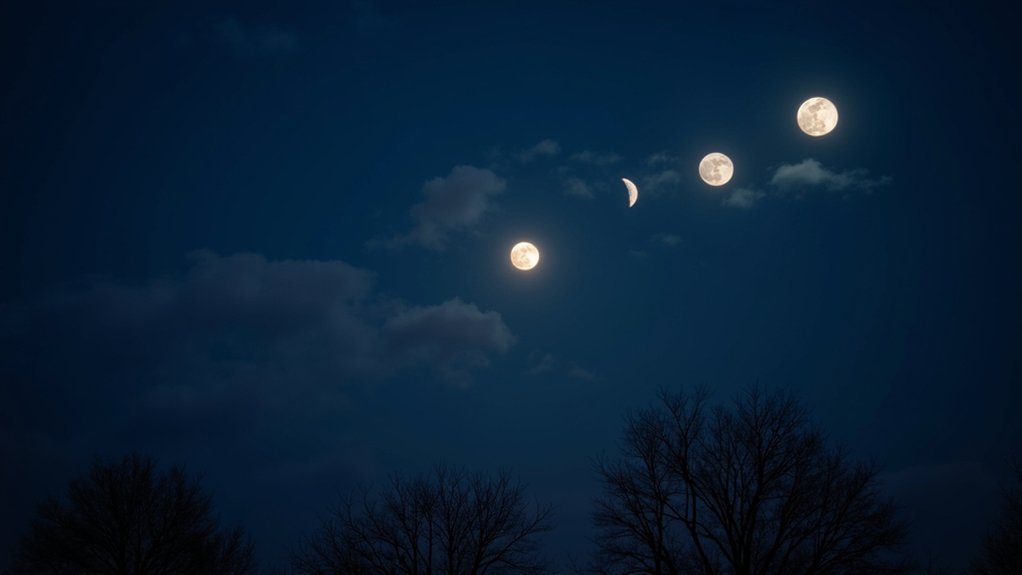
Earth’s 23.5-degree tilt creates distinct moonrise positions that shift throughout the year, with the moon appearing higher in summer skies and lower in winter.
You’ll notice the illuminated portion of the moon appears on different sides depending on your hemisphere—right-sided in the Northern Hemisphere’s summer and left-sided in winter.
These tilt-based shadow patterns affect when you’ll see the moon rise and set, creating seasonal variations in how long different moon phases remain visible in your night sky.
Seasonal Moonrise Positions
As seasons change throughout the year, you’ll notice significant differences in the Moon’s position and visibility in the night sky.
Earth’s axial tilt of approximately 23.5 degrees directly influences these seasonal moonrise positions, creating predictable patterns you can observe monthly.
During Northern Hemisphere summers, the Moon travels a higher arc across your sky, remaining visible for longer periods. Conversely, winter brings a lower lunar path with shorter viewing windows.
If you’re in the Southern Hemisphere, you’ll experience the opposite effect—higher winter moons and lower summer ones.
The Moon’s eastward orbital movement causes it to rise about 50 minutes later each day.
This daily delay, combined with seasonal variations from Earth’s axial tilt, creates the dynamic changes in the Moon’s position you witness throughout the year.
Hemisphere Viewing Differences
The Moon you see varies dramatically depending on your hemisphere. In the Northern Hemisphere, you’ll notice waxing Moon phases show illumination on the right side, while Southern Hemisphere observers see the opposite—light appearing on the left. This difference occurs because your perspective inverts when crossing the equator.
Earth’s 23.5-degree tilt creates seasonal variations in how you perceive the phases of the Moon. Near the equator, you’ll observe the terminator line (boundary between light and dark) appearing more horizontal. At higher latitudes, this line’s orientation changes considerably throughout the year.
During summer in the Northern Hemisphere, you’ll see a more vertically oriented crescent Moon that stays visible longer, while winter brings a more horizontal crescent that rises later and appears lower in the sky.
Tilt-Based Shadow Patterns
When you observe the Moon throughout the year, shadow patterns shift noticeably due to our planet’s 23.5-degree axial tilt. This tilt changes how sunlight strikes the lunar surface relative to your viewing position, creating seasonal variations in how the different phases appear.
In summer months, you’ll notice the Moon riding higher in your night sky, displaying more prominent phases with clearer shadow lines. Earth’s axial tilt positions Northern Hemisphere viewers to see the waxing crescent opening upward, while Southern Hemisphere observers see it opening downward.
As seasons progress, the Moon’s position relative to Earth and Sun shifts, altering shadow patterns across its face.
These seasonal variations aren’t just about the Moon’s orbit—they’re a direct consequence of Earth’s tilt influencing your perspective on our celestial neighbor throughout the year.
Moon’s Path Across Seasonal Night Skies
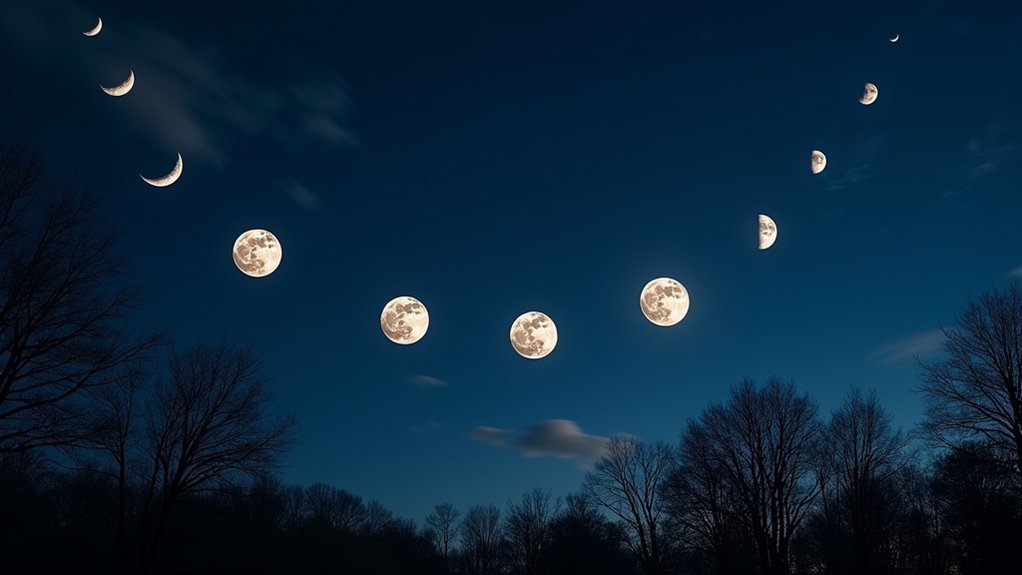
You’ll notice the Moon’s path shifts dramatically across your local night sky as seasons change, with winter moons climbing higher than their summer counterparts in the Northern Hemisphere.
This seasonal variation in lunar altitude directly impacts how long you can observe the Moon each night and when specific phases will be visible from your location.
The Moon’s changing elevation throughout the year also affects its brightness and clarity, as higher positions mean less atmospheric interference for your viewing experience.
SEASONAL PATH VARIATIONS
Throughout different seasons, our Moon traces noticeably different paths across the night sky, creating spectacular viewing opportunities that change as Earth orbits the Sun. These seasonal variations result from Earth’s axial tilt and orbital motion.
You’ll notice the Moon’s position shifts dramatically between summer and winter. In the Northern Hemisphere’s summer, the Moon rides high across the night sky, remaining visible longer. During winter, it follows a lower path, appearing for shorter durations.
The Moon also rises approximately 50 minutes later each day, a timing shift influenced by the Sun’s seasonal position.
These changing angles affect how you perceive lunar phases throughout the year. The crescent Moon’s orientation varies with the seasons, as does the Moon’s angle relative to your horizon—all creating the distinctive seasonal lunar patterns you observe throughout the year.
ALTITUDE AND VISIBILITY FACTORS
How dramatically the Moon’s altitude changes across seasons directly impacts when and how long you’ll spot it in the night sky.
During winter, you’ll notice the full Moon climbing much higher in the sky, creating improved visibility conditions as it follows a steeper trajectory across the heavens.
Summer presents a different experience. The Moon takes a shallower path, staying closer to the horizon and reducing its overall visibility time. You’ll find it rising later in summer evenings compared to winter nights when it appears earlier.
Your location matters greatly in these seasonal patterns. If you’re in higher latitudes, you’ll experience more pronounced altitude variations throughout the year.
These predictable seasonal changes explain why the Moon seems more prominent during certain months and nearly absent during others.
Waxing and Waning Through the Year
The Moon’s rhythmic dance of waxing and waning continues without pause, regardless of the season you’re experiencing on Earth. This 29.5-day cycle remains constant throughout the year, with the Moon’s phases progressing predictably from New Moon to Full Moon and back again.
You’ll always observe the same sequence—New Moon followed by waxing crescent, first quarter, and waxing gibbous before reaching the Full Moon. Then it shifts to waning gibbous, last quarter, and waning crescent before returning to New Moon.
While the Moon’s position and visibility in your night sky may shift with seasonal changes, the fundamental pattern of Moon’s phases remains unaltered. The waxing and waning cycle is determined solely by the Moon’s position relative to Earth and the Sun, not by Earth’s seasons.
Lunar Brightness and Seasonal Atmosphere
You’ll notice the Moon appearing brighter during winter months when crisp, clear air allows more lunar light to reach your eyes without atmospheric interference.
The Moon’s altitude in the sky shifts seasonally, with higher positions typically offering better visibility as moonlight passes through less atmospheric haze.
When you observe the full Moon in summer versus winter, these seasonal atmospheric differences can dramatically affect your perception of lunar brightness and detail, despite the Moon itself remaining unchanged.
Seasonal Atmospheric Clarity
Contrary to popular belief, our Moon’s visible brightness doesn’t remain consistent throughout the year. The Moon’s appearance changes dramatically based on seasonal atmospheric conditions that affect how moonlight reaches your eyes.
During winter, you’ll notice the Moon often appears brighter and more defined due to exceptional atmospheric clarity. Cold air holds less moisture, allowing lunar light to travel through the atmosphere with minimal scattering.
Summer brings higher humidity and increased atmospheric turbulence, making the Moon seem hazier and less brilliant as light particles scatter more extensively.
In autumn, you might observe enhanced lunar visibility as air shifts from summer’s humidity to clearer conditions, creating better contrast against the night sky.
These seasonal variations in atmospheric clarity explain why the same lunar phase can look remarkably different depending on when and where you’re viewing it.
Altitude Affects Visibility
Looking beyond atmospheric clarity alone, altitude plays a fundamental role in how we perceive the Moon throughout the year. When the Moon sits higher in the sky, you’ll notice increased brightness and detail as its light travels through less atmosphere to reach your eyes.
Seasonal changes directly impact these viewing conditions:
- During summer months, the Moon’s higher altitude creates ideal viewing with reduced atmospheric interference.
- Winter brings a lower Moon path, forcing light through more atmosphere and diminishing brightness.
- The angle of the Moon’s trajectory changes with seasons, affecting its maximum altitude each night.
- You’ll observe more vibrant lunar details when the Moon reaches peak altitude, regardless of season.
Understanding these altitude-visibility relationships helps you anticipate when seasonal changes will enhance your moongazing experiences.
Full Moons and Their Seasonal Names
Full Moons illuminate the night sky approximately every 29.5 days, showcasing their complete circular form when positioned directly opposite the Sun from Earth’s perspective. These monthly appearances carry traditional names that reflect seasonal activities and natural phenomena occurring during their arrival.
You’ll notice these seasonal names vary across cultures but often relate to agricultural practices and weather patterns. The Full Moon’s timing shifts slightly each year due to the lunar cycle’s interaction with Earth’s orbit.
| Season | Full Moon Names | Significance |
|---|---|---|
| Spring | Worm Moon, Pink Moon | Soil thawing, early flowers |
| Summer | Strawberry Moon, Buck Moon | Fruit harvests, deer antlers |
| Autumn | Harvest Moon, Hunter’s Moon | Crop gathering, hunting season |
These bright nocturnal displays not only guide seasonal activities but also influence tides and animal behavior throughout the year.
Northern vs. Southern Hemisphere Differences
Lunar visibility differs dramatically between the Northern and Southern Hemispheres, creating entirely different moon-watching experiences depending on your global location.
The Moon’s position and appearance reverse when you cross the equator, affecting how and when you’ll spot the waxing crescent.
Hemispheric location fundamentally transforms your lunar experience, altering both the moon’s visual orientation and its timing in night skies.
- In the Northern Hemisphere, the waxing crescent appears with darkness on the left side, while Southern Hemisphere observers see darkness on the right.
- The crescent’s orientation differs too—opening upward in evening Northern Hemisphere skies but downward in the Southern Hemisphere.
- Your latitude affects the lunar terminator’s angle; equatorial viewers see a more horizontal line dividing light and dark regions.
- Seasonal variations compound these differences, with summer bringing a higher Moon’s position in the sky and winter showing a lower trajectory.
Tracking Moonrise and Moonset Seasonally
While the Moon faithfully circles our planet every month, its daily appearance and disappearance follows a shifting schedule that transforms with each season.
You’ll notice the Moon rises approximately 50 minutes later each day, creating a predictable yet ever-changing pattern throughout the year.
In winter months, you’ll observe the Moon following a lower path across the sky, resulting in earlier moonsets and later moonrises.
Conversely, summer brings a higher lunar trajectory, altering when and where you’ll spot the Moon. This seasonal variation stems from Earth’s changing tilt angle throughout the year.
If you’re in the Northern Hemisphere, you’ll see crescent Moons in the western evening sky during summer, while winter presents them in the eastern morning sky—patterns that have guided cultural practices and agricultural activities for centuries.
Seasonal Impact on Earthshine Visibility
When observing the Moon’s dim side during crescent phases, you’re witnessing Earthshine—sunlight that bounces off our planet and gently illuminates the lunar surface. This ghostly glow varies considerably throughout the year due to seasonal changes.
To enhance your Earthshine viewing experience:
- Spring and summer evenings offer prime viewing conditions when the crescent Moon hangs in clearer, more transparent skies.
- Waxing and waning crescent Moon phases provide ideal Earthshine visibility as more of the dark side faces Earth.
- Seasonal atmospheric conditions directly affect intensity—summer’s clearer skies enhance visibility compared to winter’s turbulent atmosphere.
- Your local season influences viewing angles—the Sun’s seasonal position alters how much light Earth reflects toward the Moon.
Watch how these seasonal patterns transform this subtle lunar phenomenon throughout the year.
Photographing the Moon in Different Seasons
Capturing the Moon’s beauty requires different approaches as seasons change throughout the year.
As the Moon moves around Earth, you’ll need to adjust your photography techniques accordingly. In summer months, position your camera to capture the higher lunar crescents that result from Earth’s tilt. These waxing phases often appear inverted compared to winter views.
Adapting to the Moon’s seasonal dance transforms ordinary photos into celestial masterpieces worth capturing.
Winter photography presents challenges as the Moon follows a lower trajectory across the sky. You’ll find different parts of the lunar surface illuminated at varying angles throughout the seasons.
Remember to account for the 50-minute-later moonrise each day when planning your shots.
For the best Earthshine photos, time your sessions during crescent phases when this subtle glow is most visible—especially during certain seasons when atmospheric conditions enhance this ethereal effect.
Ancient Calendar Systems and Seasonal Moons
Beyond photographing the Moon’s beauty, humans have long used its rhythmic journey across the night sky to measure time itself. As the Moon orbits around Earth, its phases became the foundation for tracking seasons and days.
Ancient civilizations developed sophisticated lunar calendars to align with agricultural needs and cultural practices:
- Neolithic societies tracked lunar phases to plan farming activities, connecting crop cycles directly to the Moon’s visibility.
- Pure lunar calendars like the Islamic Hijri calendar contain 354 days, causing months to drift through seasonal changes yearly.
- Lunisolar calendars such as the Hebrew system add extra months periodically to align lunar cycles with solar years.
- Cultural festivals across civilizations celebrate specific Moon phases, reflecting the deep connection between lunar rhythms and seasonal changes.
Frequently Asked Questions
What Causes the Moon Phases to Change?
You’ll see the moon’s phases change because it orbits Earth every 27.3 days. As it moves, you’re seeing different amounts of the sunlit side from your perspective on Earth.
How Does the Moon Change Seasons?
The Moon doesn’t change seasons. You’re observing Earth’s seasonal changes while the Moon continues its regular 29.5-day phase cycle. The Moon’s visibility and position in your sky change as seasons progress.
Why Does the Moon Appear to Have Different Phases at Different Times of the Month?
You see different moon phases as it orbits Earth. The sun illuminates only the side facing it, so you’ll observe varying portions of the lit half depending on the moon’s position in its monthly cycle.
What Is the Reason for the Different Phases of the Moon?
You’re seeing different moon phases because the moon’s position relative to Earth changes as it orbits us, altering how sunlight illuminates its surface. This rotation creates the predictable cycle of phases you observe.
In Summary
You’ll notice the moon’s appearance changes throughout the seasons not because its phases actually shift, but because your viewing angle does. As Earth tilts through its yearly cycle, you’re observing the moon from different perspectives, against varying backdrops, and in changing atmospheric conditions. The moon itself follows consistent patterns—it’s your seasonal position on our tilted planet that transforms how you experience its celestial dance.

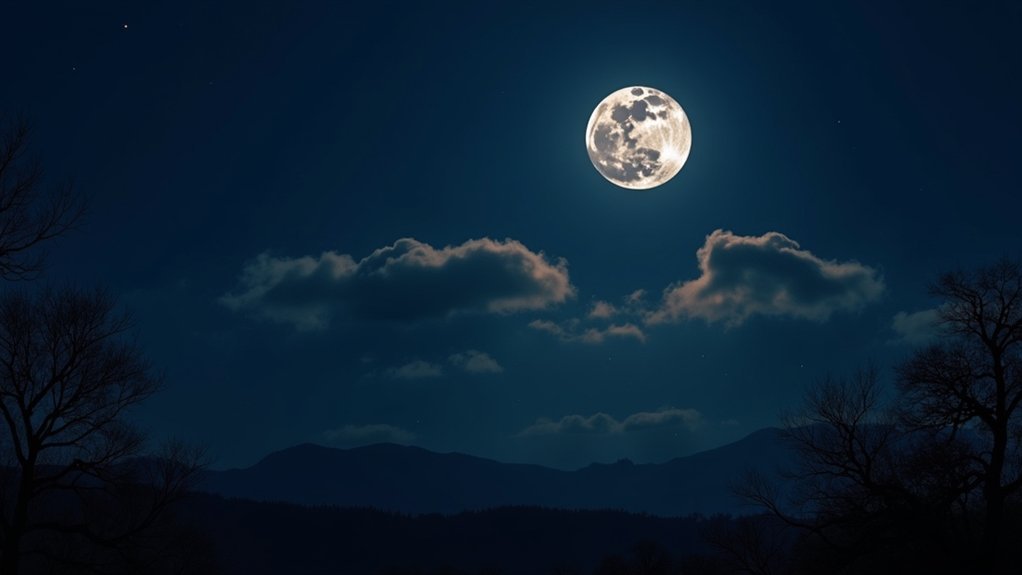

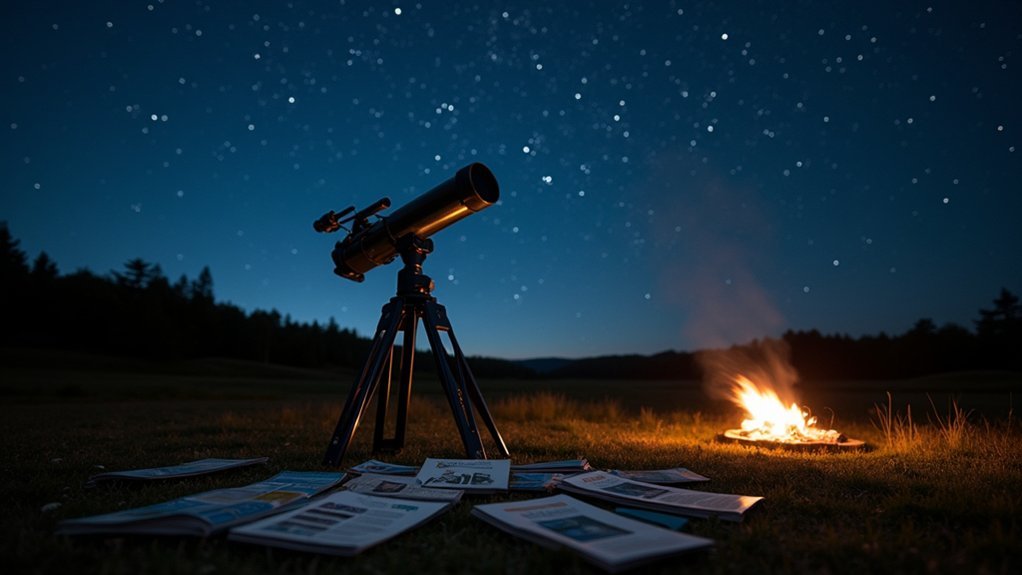
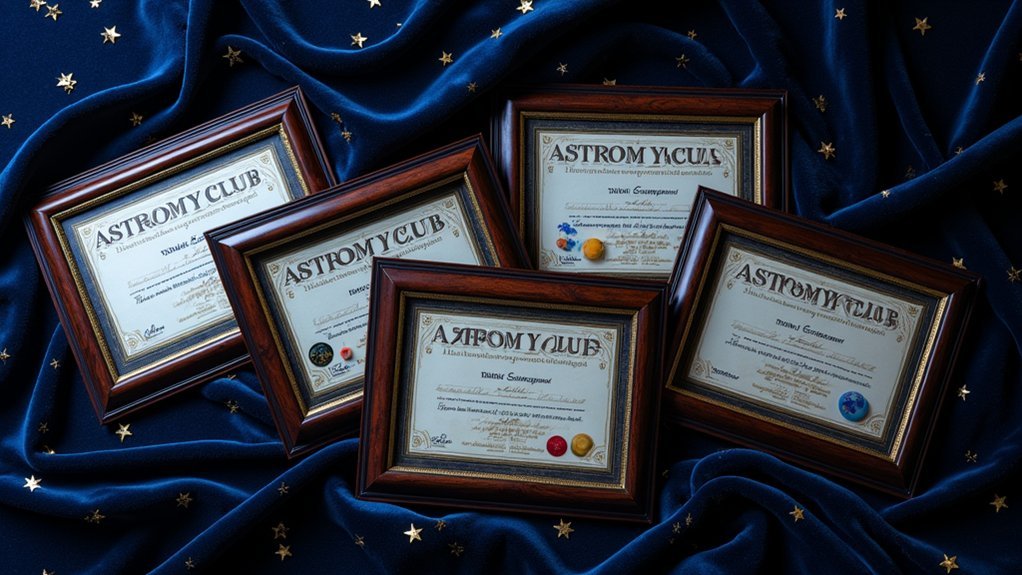
Leave a Reply